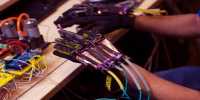Technology Change the future of Higher Education
Technology has modified the way that professors instruct higher education students. Colleges and universities have traditionally been eager to embrace emerging innovations, even before their educational importance has been proven. For example, by downloading recorded lectures online, students may link to a digital copy of the topics explored in the classroom. Computers and networks are the primary technologies for reshaping higher education. However, teaching-based teaching typically leaves students with little room for student imagination or engagement as consumers of knowledge.
The online and open world of education is transforming the way education is delivered. E-learning is expected to rise 15-fold over the next decade, accounting for 30 percent of all education provision. This change needs to be influenced by educators in order to ensure that technology is used successfully and efficiently. The effect of digital technologies will influence the learning, collaboration, and participation of students in their education.
Technology in higher education is certain, learning with it instead of from it. Colleges and universities have generally been quick to adopt new technologies, often even before their educational value has been proven.
Researchers at the University of Missouri have also discovered that activity-based learning, rather than lecture-based learning, promotes student imagination and learning by encouraging students to use technologies to create their own original ideas. The rapid progress of globalization, which reduces international borders and changes the business world, is also widening the future influence of colleges and universities.
Isa Jahnke, associate professor at the MU College of Education at the School of Computer Science and Learning Technologies, has partnered with former doctoral student Julia Liebscher to research how higher education professors in Europe use mobile devices in their classrooms. She noticed that the student’s imagination was most improved by professors who encouraged their students to use technologies in a team environment to come up with a new concept or concept. The expense of certain technical applications often prevents their fast acceptance by a variety of resource-limited organizations.
For example, a group of students in the history class has created an app that digitally informs users about the history of the Berlin Wall. Rather than merely teaching students the curriculum, Jahnke noticed that encouraging them to use technology in a collaborative manner improved students’ imagination and comprehension of the subject.
“This research is useful for professors to rethink how they design their existing courses,” Jahnke said. “We need to shift away from purely lecture-based learning where students are just consumers of information toward a more meaningful learning approach with technology where students are able to come up with creative and novel solutions in a team setting,” Jahnke added that there are opportunities at MU, such as the Teaching For Learning Hub, to help professors reconsider their course designs in the middle of the MU.
A study by educational researchers has found that interactive learning experiences improve memory, comprehension, and problem-solving. Technology can significantly promote the work of collective design teams, peer writing groups, and other forms of collaborative learning groups, including among students who do not live in the same geographical area and are unable to meet face to face.
“If we have universities that are producing more creative-thinking students, then we have more people who can help come up with solutions for all of society’s grand challenges,” Jahnke said. “Creativity will lead to better innovators, entrepreneurs, and business owners, but first we need to ask ourselves as educators if we are using technology to put our students in positions to be creative in the first place.”
The question is how do we change this technology-the first narrative of higher education changes and at the same time engaging in research and development of education technology? How are we to celebrate scientific experimentation in higher education without succumbing to the illusion that solutions to our problems will be found in technology?















